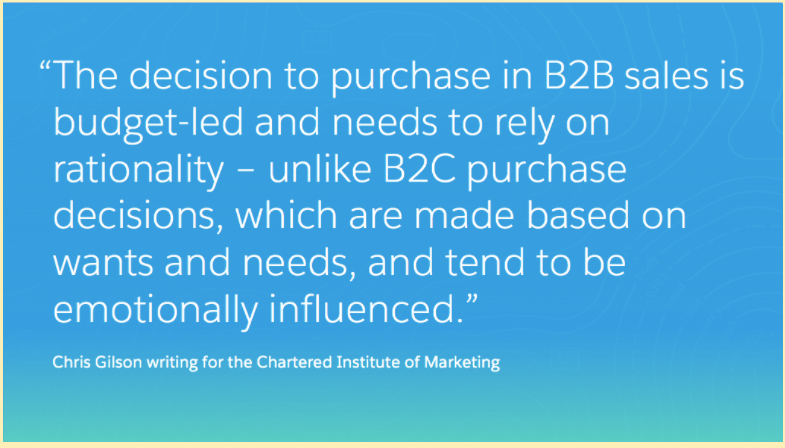Business to Business (B2B) marketing is the act of marketing products and services to businesses, rather than to individual customers (B2C).
The first thing you realise when you start marketing to businesses rather than consumers is that different rules apply. Sure, the basic principles are the same; you’ll still do things like run email campaigns, segment your audiences and try to measure response rates and ROI. But there are fundamental differences between the way you do business-to-consumer marketing and how you should approach your B2B marketing strategy.
In this article, we’ll take a look at what sets B2B marketing apart from its consumer-focused sibling.
What makes B2B marketing different to B2C?
The basic reason that B2B marketing is different is simple: companies are not the same as individual consumers, and they behave differently when they make buying decisions.
Buyers are more accountable and ‘rational’
As individual consumers, we all recognise our ability to buy things that we want but don’t strictly need, often more or less on impulse. But in a business context, we’re not spending our own money; we’re quite rightly more accountable to others and need to justify purchasing decisions to colleagues and to the organisation as a whole.

There are fewer customers out there...
“Small numbers of customers of widely different sizes – and the presence of a few key accounts – is a major distinguishing feature of business-to-business markets,” writes Nick Hague of specialist market research consultancy B2B International.
Put very simply, the number of companies that might potentially buy your product or service is far smaller than the number of potential customers for a mass-market consumer product – perhaps in the hundreds, rather than the millions. What’s more, the difference in size between your largest and smallest customer is likely to be far greater. This has several important consequences: each individual customer is more important and is worth working hard to convert and retain, while an SME customer will likely need a different approach to the one that will work for an enterprise client.
Understanding those customers’ behaviour in detail is also more important, writes Nick Hague: “Because such small numbers of customers dominate the lives of businesses, database management is a crucial part of business-to-business marketing.”
…but relationships can last longer
For a business buyer, the purchase is often just the beginning of their relationship with you as a supplier. Business buyers tend to need (and expect) more aftersales support and service. And because customers are scarce, the benefits of retaining them are greater – and the costs of losing them worse.
Having an end-to-end view of each customer that goes from the first contact through to purchase and beyond can be a vital tool in B2B sales and marketing. Sharing customer data and reporting between marketing, sales and customer service can help to improve customer retention by making sure leads are developed properly and service issues don’t fall through the gaps.
Personal connections are more important
B2B sales and marketing is characterised by longer-term relationships with fewer customers. Accordingly, B2B companies tend to spend proportionately more on salespeople and account managers who can develop and maintain personal connections with customers, learning about their needs to help them through the buying process and beyond.
Effective B2B marketing, therefore, requires comprehensive, up-to-date customer information that can support this relationship-building activity. Your CRM should enable you to track a customer throughout their relationship with your business, from first contact through to purchase and beyond. A system in which marketing, sales and other departments use the same customer information and see one another’s activity gives you the chance to really coordinate your marketing in a way that focuses on the customer.
To sum up: in business-to-business marketing, you have fewer customers, with more stringent buying criteria, who need more support and alignment from your marketing, sales and customer service teams. How do you develop a B2B marketing strategy that meets these considerable challenges? Find out in my followup post: How to Develop a B2B Marketing Strategy.
In the meantime, get an inside look at what’s top of mind for today’s CMOs and marketing leaders in the fourth annual “State of Marketing” report.








